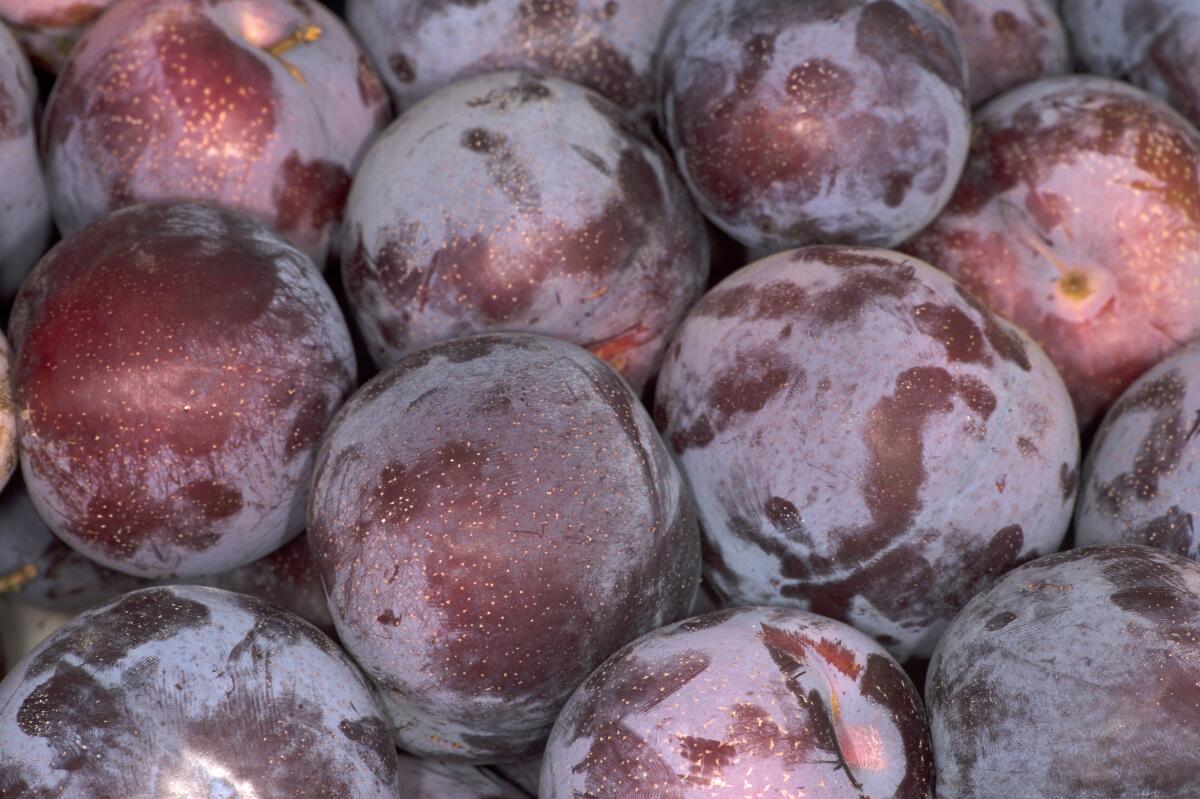Floyd Zaiger, prolific fruit breeder who brought new flavors to our lives, dies at 94

- Share via
Fruit breeders, who make crosses, plant experimental seedlings and evaluate them, generally labor in obscurity, but Floyd Zaiger, the most prolific and arguably the world’s greatest fruit breeder, was a high-profile exception.
Over six decades he and his family developed 420 fruit and nut varieties patented in the United States — by far the greatest number of any fruit breeder — and introduced Pluots, firm but sweet white-fleshed peaches and nectarines, and fruit crosses such as Peacotums previously thought to be impossible.
Zaiger died June 2 at his home in Modesto. He was 94. The cause was unclear, but he had been having trouble breathing and was under hospice care when he likely had a heart attack or stroke, and died five days later, said his daughter, Leith Gardner.
Chris Floyd Zaiger was born April 26, 1926, in Kennard, Neb., to Christian Fredrick Zaiger and Anna Marie Zaiger, the middle child of nine. His mother called him “Floyd” to distinguish him from his father, who was known as “Chris.” His family, which farmed in Iowa and later Oregon, was poor, and he left school after eighth grade. During World War II he served as a paratrooper with the U.S. Army 11th Airborne Division.
After the war he got his general equivalency diploma, attended UC Davis with support from the G.I. Bill, and graduated with a degree in plant pathology. He married Betty Jean Taylor in 1950, and taught high school in Modesto, where he started breeding azaleas and rhododendrons as a hobby.
Fred Anderson, a fruit breeder known as the inventor of the modern nectarine, took him on as an apprentice in 1956 and Zaiger learned quickly. He soon struck out on his own, running an ornamental nursery by day as he pursued his dream at home by moonlight.
“I’d caught the dreaded disease of fruit breeding,” he recalled in a 2000 interview.
He focused on improving stone fruit — peaches, nectarines, apricots, plums and cherries — and introduced his first variety, Royal Gold peach, in 1965. But he dreamed of combining plums and apricots, his two favorite fruits, like his hero, Luther Burbank, the great turn-of-the-century fruit breeder. Burbank had managed to partially overcome interspecies sterility and hybridize plumcots (half plum, half apricot), but most were small and sour, or unproductive, and they never caught on.
By making thousands of crosses, Zaiger discovered plumcots with good flavor, size and productivity.
He released a few, such as Plum Parfait and Flavorella, but the real breakthrough came when he backcrossed plumcots to plums, creating interspecific plums that he trademarked as Pluots.

These new varieties — starting with Flavor Supreme, Flavor Queen and Flavor King — were sweet, juicy and rich, and along with later varieties, revolutionized the plum category.
Today interspecific plums from the Zaigers and other breeders account for three-quarters of plum production in California, his daughter estimated.
In the 19th century, exquisitely aromatic white-fleshed peaches and nectarines were common, but so easily bruised they couldn’t be shipped, and by the mid-20th century more durable yellow-fleshed varieties predominated.
Zaiger crossed tender low-acid white peaches with firmer yellow types to create low-acid white-fleshed peaches and nectarines that were sweet when firm enough to ship, like the almost preternaturally sugary Arctic Rose. Low-acid yellow varieties followed, and today peaches and nectarines with low and intermediate acidity abound.
Zaiger and his family invented many other fruit types, including interspecific apricots, sold as Apriums; cherries with winter chilling requirements so low they can be grown in Los Angeles; crosses of cherry and plum; crosses of peach, apricot and plum sold as Peacotums or Colorcots; and even some crosses so complex that no common name for them exists.
But the family’s greatest success has been the Independence almond, which does not require pollination by bees, and is now grown on nearly 50,000 acres in California, mostly in the Central Valley.

In addition to his daughter, Zaiger is survived by his two sons, Gary and Grant, who also work in the family business, Zaiger’s Inc. Genetics; six grandchildren and 16 great-grandchildren. His wife and siblings predeceased him.
His fruit varieties live on at farms and markets around the world.
“It gives me great satisfaction,” he said of his work, “far greater than any return on investment, to create something new that gives so many people so much pleasure.”
Karp is a food writer and farmer, and frequent Times contributor
More to Read
Start your day right
Sign up for Essential California for the L.A. Times biggest news, features and recommendations in your inbox six days a week.
You may occasionally receive promotional content from the Los Angeles Times.






